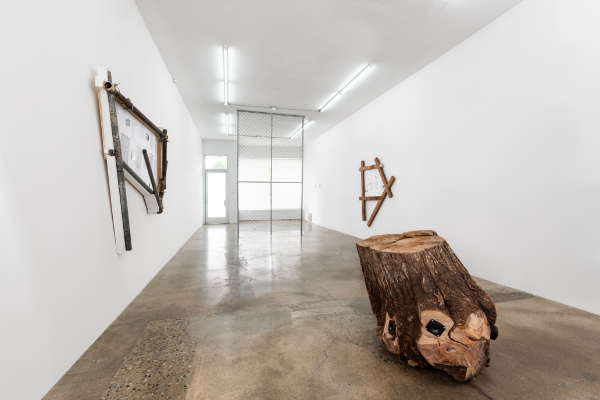Tarik Garrett’s compelling show addresses how the past intersects with the present. This minimal, mixed-media installation brings together appropriated documents, Polaroid photographs, junked wood, metal fragments, a partial tree trunk equipped with speakers and a portion of chain-link fence. Upon entry, the partially blocked space forces the viewer to navigate around a section of fence that spans the height of the gallery. Caught in the bottom of the chain-link fence are a narrow branch and a few brown leaves, suggesting the outside world where they may have once been subject to the elements.
Located toward the front of the gallery and easy to miss are two small white speakers embedded in the wall, from which a rendition of W.E.B. Du Bois’ adaptation of the patriotic song “My Country ‘Tis Of Thee” softly emanates. In the early 1900s, Du Bois’ augmented the original lyrics (written in 1831) to create a more honest depiction of the struggle of African Americans. A symphonic voice recites these altered lyrics and calls attention to racial and social injustices while simultaneously shedding light on how to interpret, or reinterpret, the other objects in the installation.

Tarik Garrett & Kevin O’Neill, 1, courtesy Hunter Shaw Fine Art, photo by Ruben Diaz.
At the far end of the gallery, a sawed stump made from cherry wood sits on the floor—titled Moses of the colored man (all works 2021)—the stump functions as a podium with an absent orator whose voice is heard from small speakers that have been inserted into the wood. The soundtrack loops a 10-minute excerpt from Military Governor Andrew Johnson’s 1864 speech, announcing emancipation in Tennessee. In the speech, emotionally and sympathetically read by Garrett and overlaid with a percussive beat, Johnson announces to a Black audience (who are suspicious of the white politician’s promises and words) the end of slavery.
Hung on opposite walls are two collage works, 1 and 2, made in collaboration with Kevin O’Neill, in which Xeroxed historical documents about race and property, including the “Virginia Health Bulletin to Preserve Racial Integrity” from 1924; pages from Cheryl Harris’ “Whiteness as Property,” 1993; and Supreme Court rulings on trespassing from 1805, are juxtaposed with Polaroids of vandalized, graffitied and fenced-in properties, as well as images of cinderblock walls. These odd-shaped assemblages are funkily framed with salvaged 2x4s or metal piping— materials that are used in ad hoc as well as sanctioned construction.
Garrett’s works speak to the continued struggles and inequities that Black American and other people of color confront in a world of white domination. By weaving together historical songs and documents from official and unofficial voices with contemporary objects and images, Garrett frames prejudices both aesthetically and critically while taking his viewers on a journey through time.











0 Comments